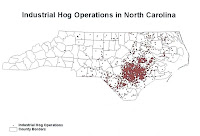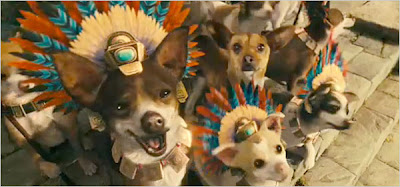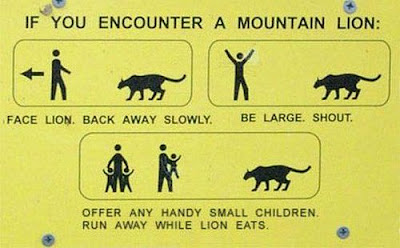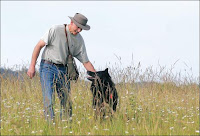 My so-called life.
My so-called life.
veryone is miserable. The mosquitoes are as big as chickens and I have no idea how they’re finding their way into the house, and I’ve been bitten so many times [5] that I’m anemic. Our rotten week:
On Monday my big male pit bull, who is eleven and arthritic and very sensitive, suddenly develops an ear hematoma. One precious velvet ear is puffed up like
roti, or a bubble on a
hot tortilla.
The vet wants some x-rays [not of the ear — we’d been concerned about a possible kidney stone], so I make an appointment and on Wednesday morning I lift the poor creature into the truck and off we go to the vet’s to get the ear and the kidney checked. Mom’s Little Lamb is desperately worried, which makes me worried, which makes him even more worried. He’s shaking like a little leaf.
At the vet’s I remind everyone that he has arthritis in his neck, and that he is extremely shy and very sensitive [he is trembling next to me and wagging his tail shyly at the same time, which looks piteous and makes me want to weep], and I give him a kiss on top of his head and tell him to Be Good, and Mom will Be Back Soon, and then the tech and I start down the hall together with him because otherwise the poor dog will sit down and refuse to budge. As soon as he’s on his way I drop back and tiptoe out of the office after double-checking that the techs in front know he is very sensitive and have all my phone numbers. It’s the crack of dawn [nine o’clock] and already hot enough to fry an egg in the truck bed.
I drive to the farm to feed the sheep. I’ve noticed one of the ewes has an odd lump just below where her Adam’s apple would be if sheep had Adam’s apples, and I’m worried she might have
CL – which I have never, in 20 years of sheep-keeping, had in my little flock. How bad is it? Two words: purulent exudate. Also: contagious. Very bad. I’m kind of
paranoid about it, actually.
To my surprise and relief L is at the farm, back from several weeks on a sheep ranch in Australia. I tell her about the ewe and ask if she’ll take a look, because L, at sixteen or thereabouts and the stepdaughter of a large-animal vet, is as good a sheep doctor as practically anyone. [She is going to be a large-animal vet herself.] She doesn’t think it’s CL [and she’s more familiar with the disease than I am], but she says, “Why don’t we draw some blood, and you can take it over to the
Davis lab. I’ll go get the stuff.”
L returns shortly with needles, etc. Since I hadn’t planned to work sheep, I have no dog.
How do I explain what this feels like? Stepping into a sheep pen without a dog is like showing up at the Battle of Thermopylae with a spork. “This! Is! Sporka! Oh, crap.” With a dog you have such a sense of confidence. Without a dog, oy.
I want blood samples from two sheep: yellow tag #- and blue tag #-. Both, like most of mine, are Border Cheviots.
To cut to the chase To make a long story short, a task that would have taken ten minutes with the help of Twiglet and five minutes with the Landshark takes rather longer. We corner the first ewe so that L can draw a blood sample, and some time later, just as I’m about to give up and drive home for a dog, L catches the second Cheviot by a hind leg and clings like grim death — she weighs less than the sheep does — and we are finally done. I drive to the Davis lab and drop off the samples, and then, with no time left to change out of clothes that smell as if I’ve been rolling in sheep dung, it’s off to the dentist’s for a check-up. Probably because he wants me out of the office as quickly as possible, the dentist finds no cavities and I race back to the animal hospital for my pit boo.
Mom’s Little Lamb is wearing a huge plastic cone and looks miserable. His ear is no longer inflated – it’s an oozing mess. No kidney stone, yay.
Once home, he pants and paces, paces and pants, around and around the dining room table in his awful cone until I’m afraid he’ll collapse. He can’t decompress. He refuses to drink. I replace the cone with a much shorter and theoretically more comfortable model [the things one collects!] but he is still determined to pant and pace. Soon I’m less worried about him and more concerned that I’ll lose my mind. The panting and pacing is worse than the worst music, worse than a colicky baby, and I am ready to kill myself, kill him and burn the house down when at last he stops, and then I’m afraid he’s dead. I bring him some water with a bit of chicken broth and he rouses himself enough to take a huge long drink, after which we both feel a bit better.
That night I carry him upstairs and put him on the bed. The idea is that I’ll be able to monitor him closely during the night, which is ridiculous since I sleep through large earthquakes, but I can’t bring myself to leave him downstairs with that cone. He sleeps stretched out in the middle of the bed and leaves me a space at the edge approximately eight inches wide, and I'm stuck there all night since he’s too heavy to move.
The next day my little female pit bull develops an odd, itchy skin problem. West Nile Virus? I make an appointment with the holistic vet, but something is wrong with my ankle, which looks and feels sprained, and I have to cancel the appointment. The next day the ankle is so bad I ask a friend to feed the sheep.
On Friday I get email from the Davis lab with word that both tests were negative!, negative for CL! Yay! Although they could both be false negatives. In any event, the sheep look all right and the dogs are doing a little better, so maybe we’ll live.
Some endearing things about sleeping pit bulls:
1) They are the soundest sleepers in the animal kingdom. Or perhaps the most extremely relaxed sleepers. It’s kind of fun to see what you can do with them without actually waking them up. Pick up a leg, put it down; pick up an ear, put it down; wag the tail gently; pick up the paws and do a patty-cake thing: they’re relaxed as rag dolls. You could never in a million years do this with a border collie, but my pit bulls sleep right through it, and if the eyelids start to open or the tail starts to thump-thump, I say, “It’s all right – go back to sleep,” and they’re out again.
2) They snore. It's adorable.
3) Pit bulls settle in for a good sleep with the most excellent sighs that anyone can imagine. Once my pibbles are about to doze off, they give such deep, loud, comfortable sighs that it’s contagious; you have to sigh a big comfortable sigh, too. And then you feel very relaxed and fall asleep right away. Forget artificial sleep aids – adopt a pit bull ;~)
 This just in from the Commission for the Promotion of Virtue and the Prevention of Vice: on Wednesday it became illegal to walk dogs [or cats!] in public in Riyadh.
This just in from the Commission for the Promotion of Virtue and the Prevention of Vice: on Wednesday it became illegal to walk dogs [or cats!] in public in Riyadh. 
























